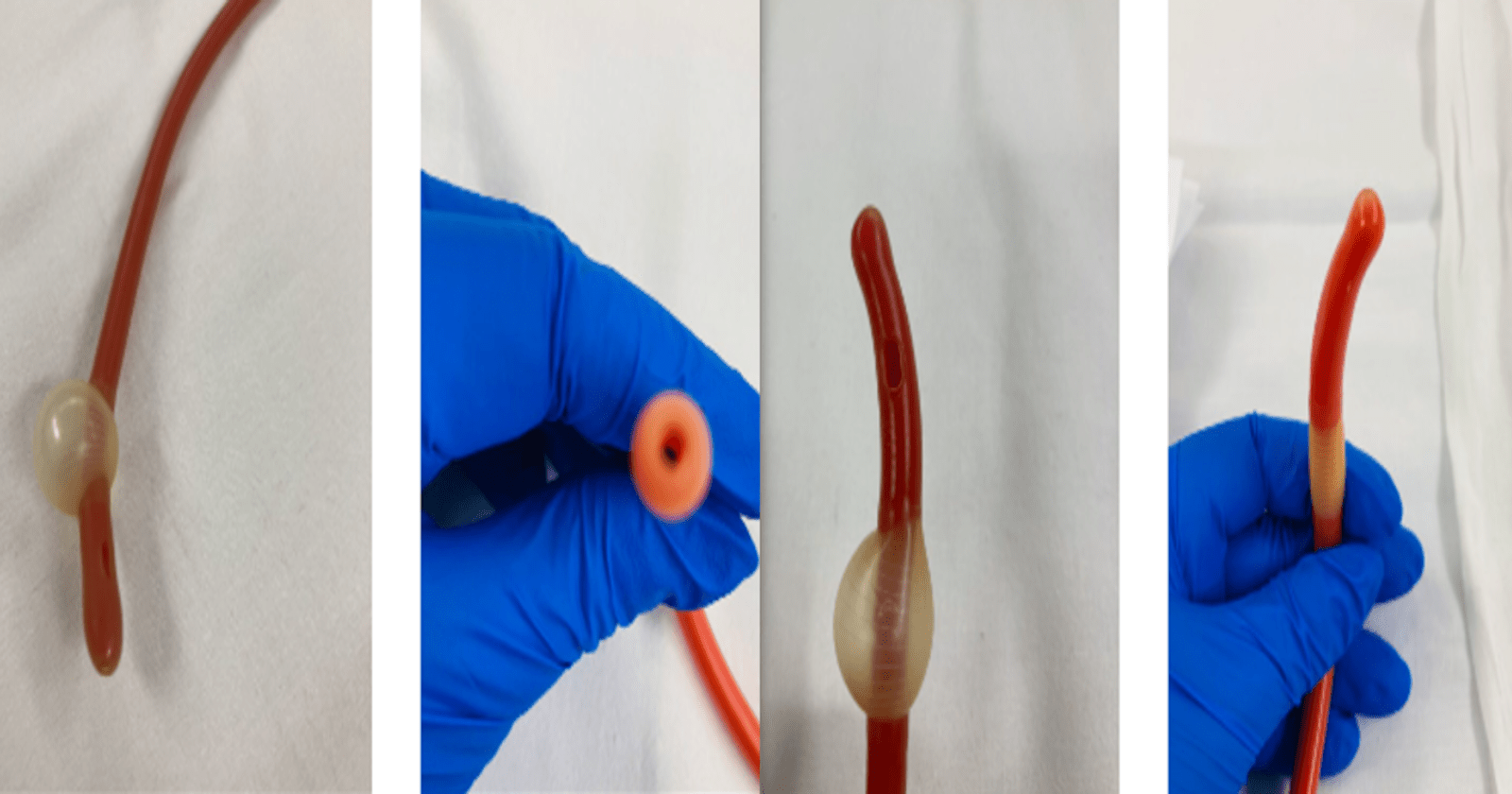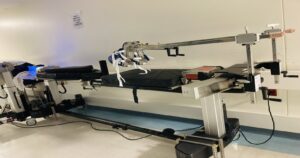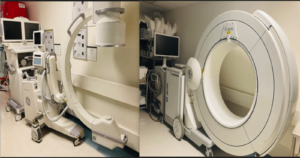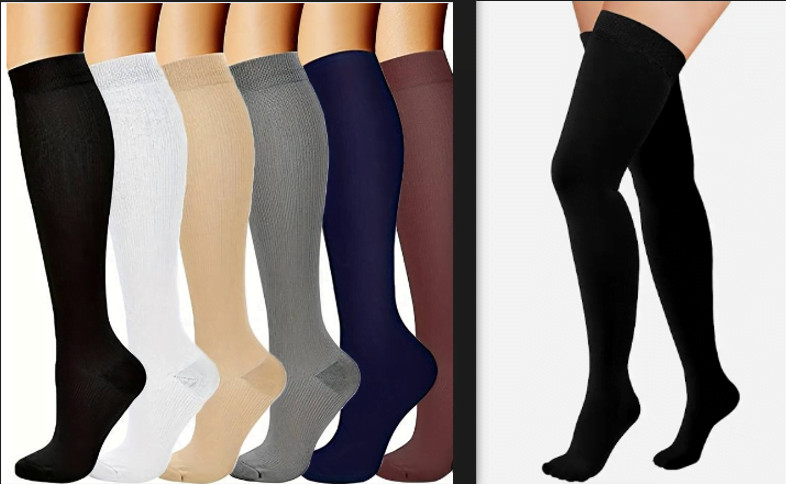Council tip Foley catheter has a whole on both side of the catheter tip, a small hole at the end, which allows them to be threaded over a guide wire vs Coude catheter which has only one hole on the side of the tip, cannot be threaded, a curved or bent tip, designed to navigate around obstacles in the urethra more smoothly, minimizing discomfort and potential injury.
In the realm of urological care, two indispensable tools emerge to address specific challenges faced by patients, the Council tip Foley catheter and the Coude Foley catheter.
The Foley, named after its inventor Dr. Frederic Foley, stands as a versatile workhorse in urinary management. It boasts a distinctive balloon at its tip, allowing for secure placement within the bladder, ensuring continuous drainage.
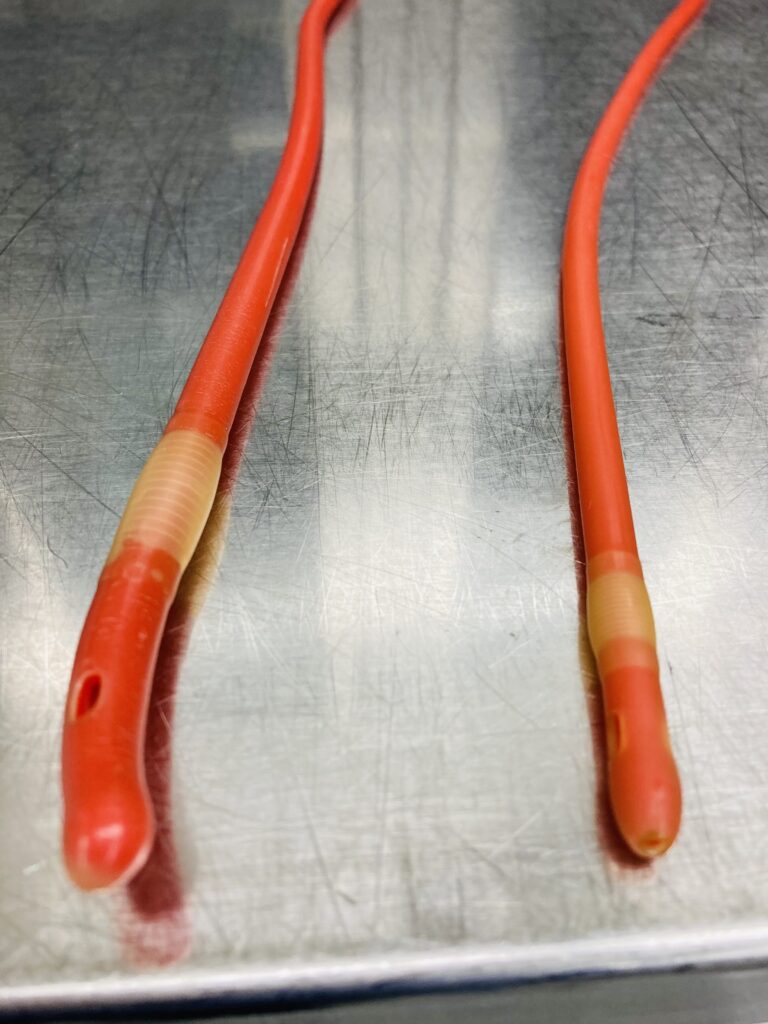
From left to right Coude Foley Catheter vs Council Tip Foley.
Conversely, the Coude catheter, bearing the namesake of the French word for “elbow,” embodies a unique curvature at its tip, designed to navigate the often complex anatomical contours, making it an invaluable tool for patients with enlarged prostates or strictures.
These two catheters, though sharing a common purpose, diverge in their design and application, offering tailored solutions for the diverse array of challenges that clinicians encounter in the realm of urological care.
Council Tip Foley vs. Coude Catheters: A Detailed Comparison
| Council Tip Foley Catheter | Coude Foley Catheter |
|---|---|
| Rounded with an open end for guidewire insertion | Angled or curved tip with a slightly bent end |
| Used primarily in urological procedures that require guidewire insertion | Used for catheterization in patients with urethral obstructions, such as an enlarged prostate |
| Facilitates the use of a guidewire for difficult catheterization | Designed to navigate around obstructions in the urethra |
| More suitable for complex catheterizations requiring precision with a guidewire | Easier to insert in patients with anatomic difficulties, such as urethral strictures or enlarged prostates |
| Patients with difficult urethral anatomy or when a guidewire is required | Patients with benign prostatic hyperplasia (BPH) or other obstructive urological conditions |
| Less flexible due to the guidewire compatibility | More flexible to navigate through the urethral passage |
| Typically made of silicone or latex | Usually made of silicone or latex |
| Available in standard catheter sizes (e.g., 14-22 Fr) | Available in standard catheter sizes (e.g., 14-22 Fr) |
| Standard Foley catheter length (usually 16 inches for males) | Standard Foley catheter length (usually 16 inches for males) |
| Used in both male and female patients requiring complex catheterization | Primarily used in male patients with prostatic obstruction |
| Requires more skilled technique due to guidewire use | Can be inserted by standard techniques by experienced clinicians |
Design Differences
- Council Tip Foley Catheter:
- Structure: The Council Tip Foley catheter is a variation of the traditional Foley catheter, featuring a reinforced or thickened tip with a small hole or eye at the end. This design allows for the catheter to be introduced over a guidewire, which can be essential in cases where traditional insertion is challenging.
- Flexibility: The reinforced tip of the Council catheter provides additional rigidity, which can aid in difficult insertions. The catheter itself remains flexible, similar to standard Foley catheters, allowing it to navigate the urethra smoothly.
- Usage: The Council Tip is particularly useful in scenarios where a guidewire is needed, such as in patients with complex urological conditions.

- Coude Catheter:
- Structure: The Coude catheter features a curved or bent tip designed to navigate around obstructions, such as an enlarged prostate or strictures. The curve provides an anatomical advantage by helping the catheter bypass these obstacles.
- Flexibility: The tip is more rigid compared to the shaft, providing the necessary firmness to navigate the urethra while the rest of the catheter remains flexible to ensure patient comfort during insertion.
- Usage: The Coude catheter is the catheter of choice in patients with BPH or urethral strictures, where a standard straight-tip catheter might encounter resistance.
Material Composition
- Council Tip Foley Catheter:
- Latex: Many Council Tip Foley catheters are made from latex, offering flexibility and durability. Latex catheters are generally softer but can cause allergic reactions in some patients.
- Silicone: Silicone versions are available for patients with latex allergies. Silicone is biocompatible, hypoallergenic, and suitable for long-term use, though it may be stiffer compared to latex.
- Coatings: Some Council Tip catheters are coated with materials like hydrophilic coatings, which allow for smoother insertion and reduce the risk of trauma.
- Coude Catheter:
- Latex: Often made from latex, Coude catheters offer the right balance of flexibility and rigidity, with the curved tip providing the structural support needed for challenging insertions.
- Silicone: Silicone Coude catheters are also available, offering hypoallergenic options for patients with sensitivities. Silicone’s biocompatibility makes it a good choice for long-term catheterization.
- Polytetrafluoroethylene (PTFE) Coating: Some Coude catheters are coated with PTFE or similar materials to enhance glide, minimize friction, and reduce discomfort during insertion.
Council Tip Foley Explained
A council tip catheter, much like other types of catheters, consists of a long, flexible tube with a narrow opening at one end. The opposite end can be connected to a catheter bag, creating a closed system for efficient urine drainage in medical situations.
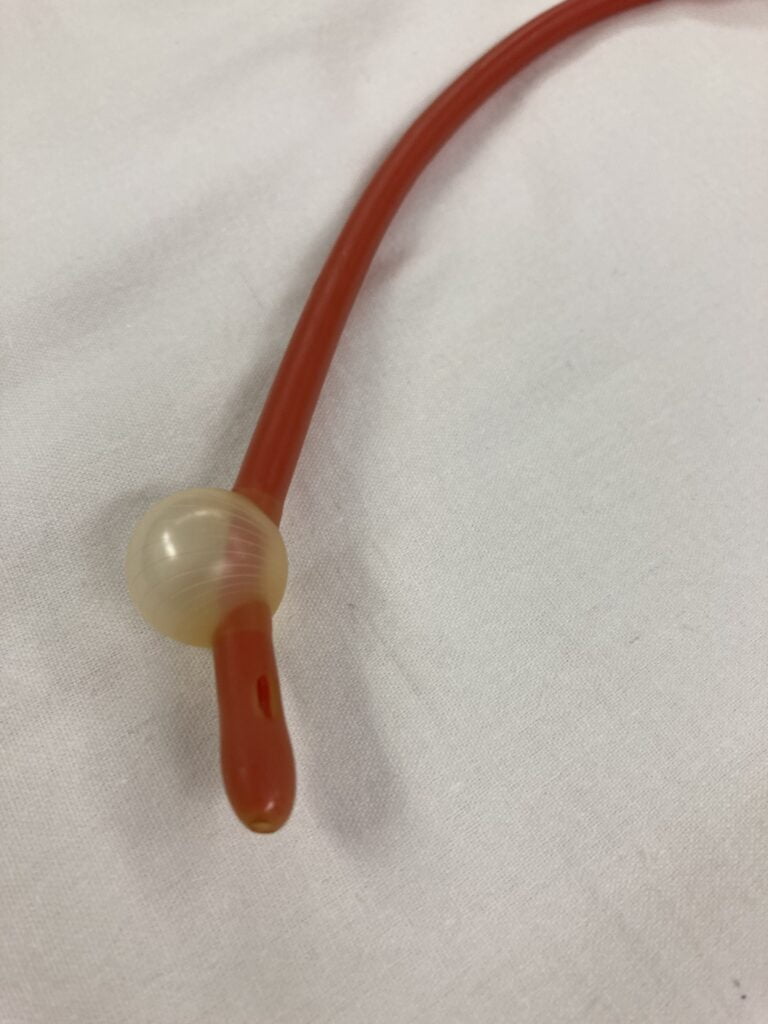
council tip catheter


The distinctive feature of council tip catheters lies in their specialized tip; these catheters possess an exceptionally small hole at the end. This design allows them to be threaded over a wire, which can be crucial for guided catheterization, especially for patients with specific medical conditions.
A Council tip has a whole on both side of the catheter tip while a Coude catheter has only one hole on the side of the tip.

Council Tip Foley demonstration of hole on both side
While the small aperture in council tip catheters may seem like a subtle feature, its importance is significant and plays a crucial role in the catheter’s functionality. This feature facilitates the insertion process, making it possible to use these catheters in patients with urethral blockages or other related issues.
These catheters closely resemble standard straight tip and coudé tip Foley catheters in both their design and application. The only distinguishing features among various models are variations in size, color, and the number of lumens at the end connected to the catheter bag.
The use of a transurethral placed Council-tip catheter facilitates urethral suture placement when performing the urethral-vesical anastomosis following radical retropubic prostatectomy. The technique for use of this catheter is described.
A Council tip catheter, design is intended to facilitate insertion in cases where there may be an obstruction or anatomical variation in the urethra.
Situations in which a Council tip Foley catheter is preferred over a regular Foley catheter:
- Urethral Strictures: Council tip catheters are particularly useful in cases of urethral strictures. The tapered and curved design can help navigate through narrowed or obstructed passages more easily.
- Prostatic Hypertrophy: In cases of benign prostatic hyperplasia (enlarged prostate), navigating the catheter past the obstructed prostate can be challenging. The Council tip’s design may make this process easier.
- Urethral Trauma: If there has been recent trauma to the urethra, a Council tip catheter may be preferred to minimize further damage during insertion.
- Urethral Anomalies: In individuals with congenital or acquired urethral anomalies, a Council tip catheter might be chosen to navigate any irregularities or obstructions.
- Previous Catheter Insertion Difficulties: If a patient has a history of difficulty with catheter insertion, especially due to urethral anatomical issues, a Council tip catheter might be considered.
- Post-Surgical Scarring: After certain urological surgeries, there can be scarring that makes catheter insertion more challenging. A Council tip catheter may be selected to assist with navigation.
- Bladder Outlet Obstruction: In cases where there is a blockage at the outlet of the bladder, a Council tip catheter might be preferred to negotiate around the obstruction.
- Patient Comfort and Tolerance: Some patients may find that a Council tip catheter is more comfortable during insertion, especially if they have experienced discomfort or resistance in the past with standard Foley catheters.
It’s important to note that the choice between a Council tip catheter and a regular Foley catheter should be made based on a careful assessment of the individual patient’s anatomy, medical history, and any potential obstructions or difficulties anticipated during insertion.
Ultimately, the decision should be made by a healthcare professional with expertise in urological care, and the procedure should be performed with meticulous attention to sterile technique and patient comfort.
How to Insert a Council tip Foley and a Coude Foley
Insertion Techniques
- Council Tip Foley Catheter Insertion:
- Preparation: Sterilize the area, prepare the catheter and guidewire. Lubricate the catheter and guidewire well.
- Insertion Process:
- Insert the guidewire into the urethra, navigating through any anatomical obstacles with precision.
- Once the guidewire is in place, advance the Council Tip Foley catheter over the guidewire.
- As urine begins to flow, advance the catheter slightly further to ensure proper placement.
- Inflate the balloon with sterile water to secure the catheter.
- Remove the guidewire carefully, ensuring that the catheter remains in place, and attach to a drainage bag.
- Considerations: The use of a guidewire requires a certain level of skill and precision. This technique is done by healthcare professionals such as a Urologist and should not be attempted by an untrained professional. It is done under video guidiance or imaging to prevent further complications.
- Coude Catheter Insertion:
- Preparation: Sterilize the area and prepare the catheter. Lubricate the catheter thoroughly, particularly around the curved tip.
- Insertion Process:
- Position the patient appropriately and hold the penis or labia to access the urethral opening.
- Keeping the tip pointing upwards, gently insert the catheter into the urethra with the curved tip facing upward (toward the patient’s abdomen).
- Apply gentle pressure and rotate the catheter slightly to help navigate around obstructions like an enlarged prostate.
- Once urine flows, advance the catheter a bit further to ensure it’s properly positioned.
- Inflate the balloon if necessary and secure the catheter.
- Considerations: The curved tip must be aligned correctly to bypass obstructions effectively. Training or professional assistance may be required for caregivers or patients.
How to maintain and care for Coude and Council tip foley catheter
Long-term use and maintenance of Council tip Foley and Coude catheters require careful attention to hygiene and regular monitoring to prevent complications such as infections. Here are some best practices:
Cleaning Protocols
- Daily Cleaning: Clean the area around the catheter insertion site daily with mild soap and water. Avoid using alcohol or harsh cleansers, as they can irritate the skin.
- Hand Hygiene: Always wash your hands thoroughly with soap and water before and after handling the catheter or drainage bag to reduce the risk of introducing bacteria.
- Drainage Bag Care: Empty the drainage bag at least every 8 hours or when it is two-thirds full. Clean the bag with a mixture of water and white vinegar or a mild bleach solution regularly. Always wash your hands before and after emptying the bag.
- Switching Bags: Use a clean, closed system to change from a daytime leg bag to a nighttime drainage bag. Ensure that the new bag is sterile and that you connect it without contaminating the catheter tip.
How to Prevent a foley Infection
- Maintain a Closed System: Do not disconnect the catheter from the drainage bag unless absolutely necessary. Keeping the system closed reduces the risk of introducing bacteria into the bladder.
- Hydration: Drink plenty of fluids (unless otherwise advised by your healthcare provider) to keep the urine flowing and reduce the risk of infection.
- Proper Positioning: Ensure that the drainage bag is always below the level of the bladder to prevent backflow of urine, which can cause infections.
- Monitor for Signs of Infection: Be vigilant for symptoms like fever, chills, cloudy or foul-smelling urine, and discomfort around the catheter site. If these occur, contact your healthcare provider immediately.
- Regular Check-Ups: Schedule regular follow-up appointments with your healthcare provider to monitor the catheter’s condition and to ensure it is functioning properly.
- Catheter Replacement: Foley catheters are typically replaced every 2-4 weeks, while council tip and Coude catheters may have a slightly different schedule based on individual needs. Follow your healthcare provider’s guidance on when to replace the catheter.
Additional Tips
- Lubrication: Use a water-based lubricant during catheter insertion if required to reduce friction and discomfort.
- Secure the Catheter: Ensure the catheter is securely taped or fastened to prevent unnecessary movement, which can cause irritation or lead to infection.
Maintaining strict hygiene and following these guidelines can help ensure the long-term effectiveness of both Foley and Coude catheters while minimizing the risk of complications.
Best practices in preventing Foley Catheter infection
Infection control is a critical aspect of catheter care, as catheters are associated with a significant risk of infection, particularly urinary tract infections (UTIs). Best practices in infection prevention are essential to minimize these risks. Here’s an overview, with a focus on Foley and Coude catheters:
1. Hand Hygiene
- Before and After Handling: Always perform hand hygiene before and after touching the catheter or catheter site. Use soap and water or an alcohol-based hand sanitizer.
- Glove Use: Wear sterile gloves when inserting or handling the catheter to prevent contamination.
2. Sterile Insertion Technique
- Aseptic Technique: Use a sterile technique during catheter insertion. This includes using sterile gloves, drapes, antiseptic solutions (such as chlorhexidine), and sterile instruments.
- Insertion Environment: Ensure that the environment is clean and as sterile as possible during catheter insertion.
3. Catheter Maintenance
- Closed Drainage System: Maintain a closed drainage system to prevent the introduction of pathogens. Avoid breaking the system unless absolutely necessary.
- Securement: Secure the catheter properly to prevent unnecessary movement, which can cause trauma and increase the risk of infection.
- Regular Inspection: Inspect the catheter and surrounding area regularly for signs of infection, such as redness, swelling, or discharge.
- Perineal Care: Perform regular perineal hygiene with soap and water to reduce the risk of infection. Avoid the use of antiseptic solutions for routine care, as this can lead to irritation.
4. Appropriate Catheter Selection
- Foley Catheters: Generally used in standard urinary catheterization. Considered suitable for most patients unless specific conditions necessitate an alternative.
- Coude Catheters: Preferred for patients with an enlarged prostate, urethral strictures, or other obstructions where a curved tip aids in navigation. Using the correct catheter type reduces trauma and infection risk.
5. Catheter Securement Devices
- StatLock or Other Securement Devices: Use catheter securement devices to stabilize the catheter and reduce the risk of urethral trauma, which can lead to infections.
6. Routine Catheter Care
- Cleaning Protocols: Clean the catheter site regularly with mild soap and water. Avoid using lotions, powders, or creams around the catheter site unless prescribed by a healthcare provider.
- Bag Positioning: Ensure the drainage bag is always below the level of the bladder to prevent backflow, which can introduce bacteria into the urinary tract.
7. Timely Catheter Removal
- Minimize Duration: Remove the catheter as soon as it is no longer necessary. The longer a catheter remains in place, the higher the risk of infection.
- Evaluate Necessity Daily: Regularly assess whether the catheter is still needed and remove it promptly if not.
8. Patient Education
- Instruction on Hygiene: Educate patients and caregivers on proper catheter care, hygiene practices, and signs of infection to watch for.
- Alertness to Symptoms: Ensure patients are aware of symptoms that indicate a potential infection, such as fever, chills, or changes in urine color or smell.
9. Use of Antimicrobial Catheters
- Silver-Alloy or Antibiotic-Impregnated Catheters: In certain cases, using antimicrobial catheters may reduce the risk of catheter-associated UTIs, especially in patients with long-term catheterization.
10. Surveillance and Reporting
- Infection Tracking: Monitor and track infection rates associated with catheter use. Implement corrective actions if infection rates rise above acceptable levels.
- Adverse Event Reporting: Report and analyze any infections that occur to understand root causes and prevent future occurrences.
By following these best practices, healthcare providers can significantly reduce the risk of catheter-associated infections, ensuring better patient outcomes. The key is meticulous care, regular assessment, and patient education.
Disadvantages of a Council Tip Foley
- Limited Applicability: A Council tip catheter is specifically designed for cases where there may be obstructions or anatomical variations in the urethra. In situations without these specific challenges, a standard Foley catheter may be more appropriate.
- Not Suitable for Every Patient: It may not be the best choice for patients without any specific urethral obstructions or difficulties. In such cases, a regular Foley catheter may be easier to insert and less likely to cause discomfort.
- Risk of Trauma: While the tapered, curved design is intended to facilitate insertion in challenging situations, it can potentially cause trauma or irritation if not inserted carefully. This risk is especially relevant if the catheter is forced against resistance.
- Potential for Discomfort: Some patients may find the Council tip catheter less comfortable during insertion compared to a standard Foley catheter. It’s important to use appropriate lubrication and technique to minimize discomfort.
- Requires Skilled Insertion: Inserting a Council tip catheter requires skill and experience, as navigating through obstructed or narrow passages can be challenging. It should be performed by a healthcare professional with expertise in urological care.
- Possibility of Failure: In some cases, even with a Council tip catheter, it may still be difficult or impossible to navigate past a severe obstruction or anomaly. In such situations, alternative approaches may be necessary.
- Potential for Complications: As with any catheterization procedure, there is a risk of complications such as urinary tract infections, bladder spasms, or catheter-associated trauma. These risks should be carefully weighed against the potential benefits.
- Cost Considerations: Council tip catheters may be more expensive than standard Foley catheters. The added cost should be justified by the specific clinical need for this type of catheter.
It’s important to note that the choice between a Council tip catheter and a regular Foley catheter should always be based on a thorough assessment of the individual patient’s condition, anatomical factors, and any potential obstructions or difficulties anticipated during insertion. The procedure should be performed by a qualified healthcare professional with expertise in urological care, using proper sterile technique and considering the patient’s comfort and well-being.
Coude foley catheter What you need to know
A Coude (pronounced kood) Foley catheter is a type of urinary catheter used for people with enlarged prostates or other conditions that might make it difficult to pass a regular straight catheter through the urethra.
The key feature of a Coude catheter is the curved or bent tip. This design helps navigate around obstructions or tight spots in the urethra more easily, reducing discomfort and potential injury.
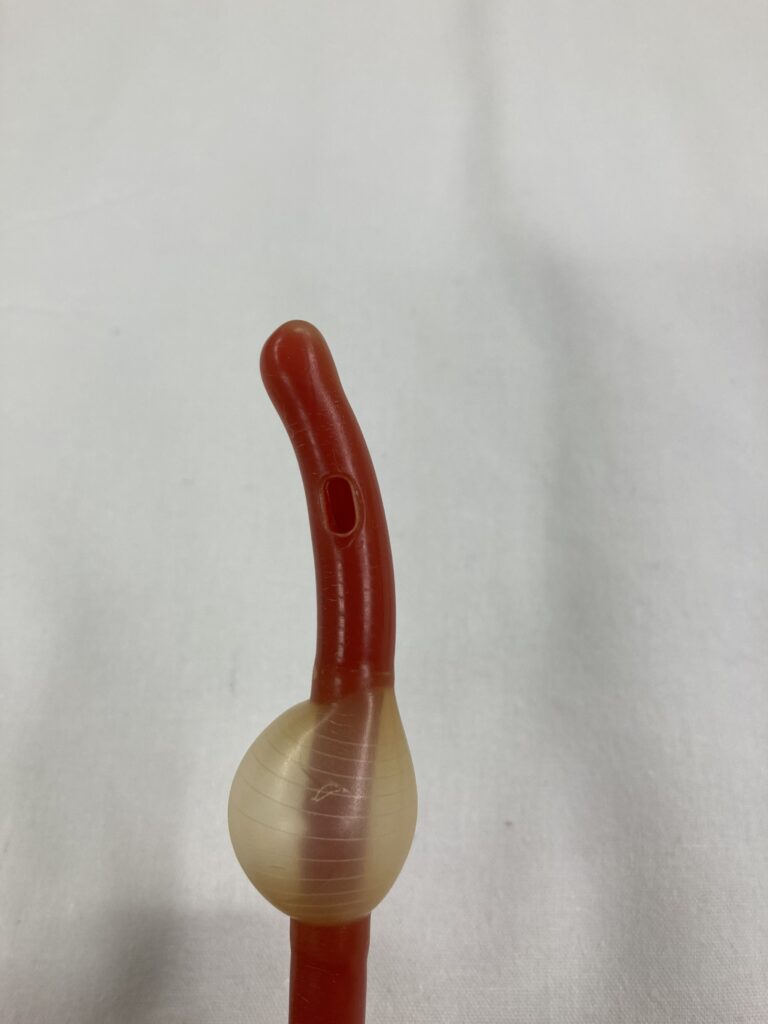


Coude Foley Tip
It’s important to note that using a Coude catheter should be determined and prescribed by a healthcare professional. They will consider the specific medical condition and anatomy of the patient before deciding if this type of catheter is necessary.
A Coude Foley catheter differs from a council tips Foley catheter. It features a curved tip and lacks a hole at the end. It is not designed for insertion with a guide wire.
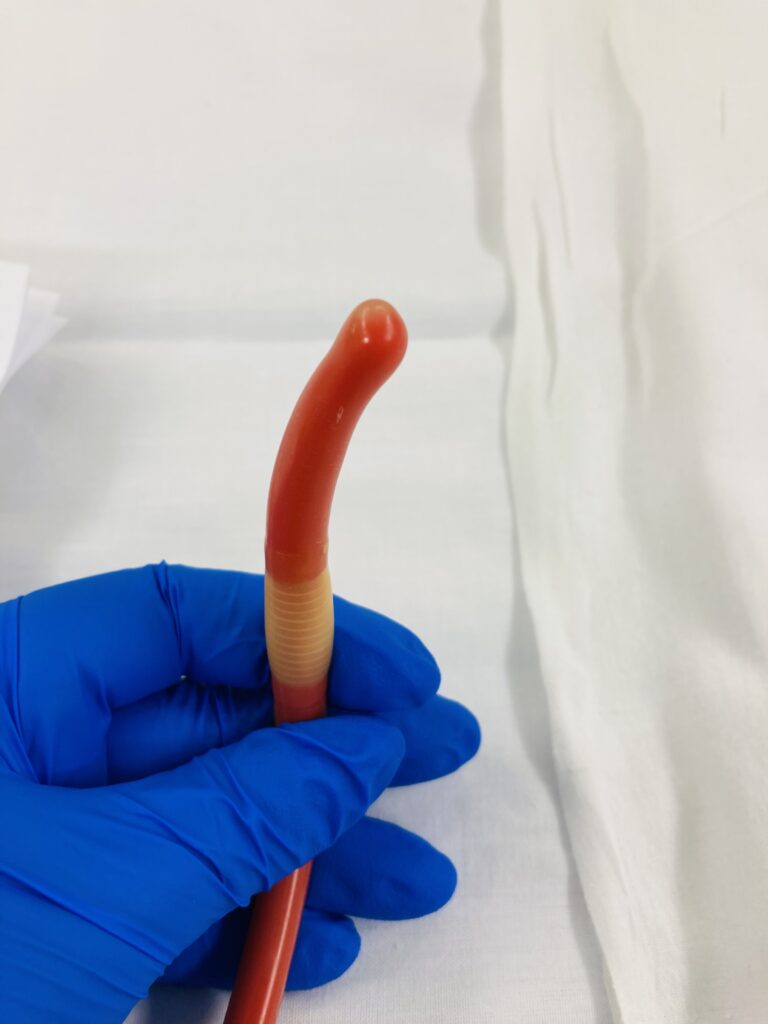
Coude no hole on Tip
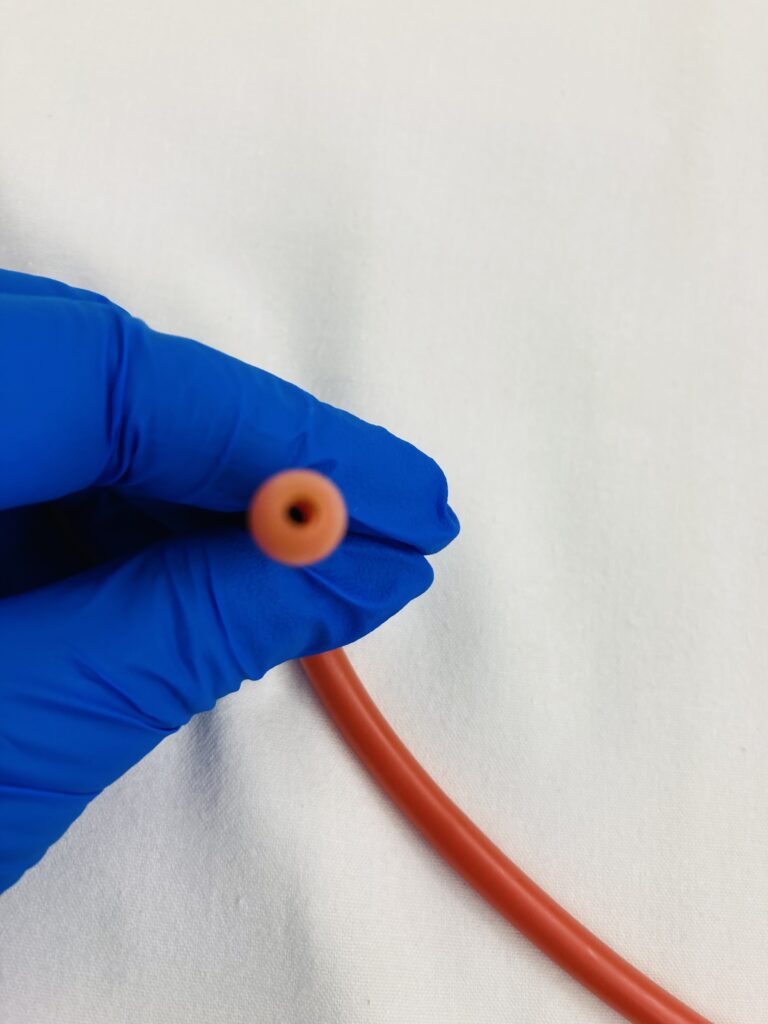
Council tip ,hole on tip
A Coude catheter, with its curved tip, is specifically designed to navigate certain anatomical obstacles that a straight-tipped catheter might struggle with.
A Coude Foley Catheter have only one hole on the side while a council tip has three holes, one each on both sides and one at the tip.

council tip with the black thread through its hole and coude catheter tip with the brown tooth pick in its hole.
key features of the coude foley catheter
- Curved Tip: The term “Coude” actually refers to the curved or bent tip of the catheter. This design is particularly useful for navigating through the male urethra, especially if there are obstacles or obstructions.
- Stiffness: Coude catheters are typically firmer compared to regular straight catheters. This added stiffness can help in guiding the catheter through the urinary tract more effectively.
- Specific Use Cases: Coude Foley catheters are often recommended for patients with an enlarged prostate (benign prostatic hyperplasia or BPH) or other conditions that might cause difficulty in navigating a straight catheter through the urethra. The curved tip aids in getting past these obstacles more easily.
- hole: have only one whole on one side.
When Not to Use Coude Catheter foley
Certain patient conditions or needs may necessitate alternatives to Foley or Coude catheters. These include:
- Short-Term Urinary Retention
- Intermittent Catheterization: For patients with temporary urinary retention, intermittent catheterization (self-catheterization) may be more appropriate. It involves inserting a catheter to drain the bladder and then removing it immediately after, reducing the risk of infection compared to long-term catheterization.
- Increased Risk of Urethral Trauma
- Suprapubic Catheters: In patients with a high risk of urethral trauma or strictures, such as those with severe urethral damage or long-term catheterization needs, a suprapubic catheter may be recommended. This catheter is inserted directly into the bladder through the abdominal wall, bypassing the urethra entirely.
- Obstructions or Anatomical Challenges
- Intermittent or Suprapubic Catheters: Patients with significant urethral obstructions, such as large prostate enlargement or severe urethral strictures, might benefit more from intermittent catheterization or a suprapubic catheter rather than a Foley or Coude catheter.
- Neurogenic Bladder
- Condom Catheters: Male patients with neurogenic bladder who have some bladder control may benefit from an external condom catheter, which reduces the risk of infection by avoiding internal catheterization.
- Patients with Latex Allergies
- Silicone Catheters: For patients with latex allergies, silicone catheters or non-latex alternatives should be used instead of standard Foley or Coude catheters to prevent allergic reactions.
Emerging Technologies
- Non-Invasive Alternatives
- Portable Bladder Scanners: Used to measure residual urine volume non-invasively, helping to determine the need for catheterization.
- Uroflowmetry Devices: These devices measure urine flow rate and can be useful for assessing bladder function without the need for catheter insertion.
- Innovative Catheter Designs
- Hydrophilic Catheters: These catheters are coated with a hydrophilic layer that becomes slippery when wet, reducing friction during insertion and removal. This minimizes trauma and infection risks.
- Antimicrobial Catheters: Catheters impregnated with antimicrobial agents, such as silver alloy or antibiotics, are being developed to reduce the incidence of catheter-associated infections.
- Smart Catheters: These are catheters equipped with sensors that can monitor bladder conditions in real-time, providing feedback on pressure, urine output, and the presence of infection.
- External Collection Devices
- Urinary Sheaths for Men: These devices resemble a condom and connect to a drainage bag, providing a non-invasive alternative for male patients with incontinence.
- Female External Catheters: Newer designs, such as the PureWick system, are available that allow for non-invasive urine collection in women by placing a wicking device between the labia.
- Bioengineered Solutions
- Tissue-Engineered Bladder Constructs: Although still in experimental stages, tissue-engineered bladder constructs are being explored as a long-term solution for patients with severe bladder dysfunction.
- Regenerative Medicine Approaches: Research into regenerative medicine aims to develop techniques that could one day repair or replace damaged bladder tissue, potentially reducing the need for long-term catheterization.
When to Consider foley catheter Alternatives
- Chronic Infection Risk: Patients with a history of recurrent urinary tract infections may benefit from alternatives that reduce the risk of infection.
- Mobility Issues: Patients with limited mobility who struggle with traditional catheters may find external or non-invasive options more comfortable and manageable.
- Quality of Life Concerns: For patients where long-term catheter use significantly impacts their quality of life, non-invasive alternatives or emerging technologies should be explored to improve comfort and reduce complications.
These alternatives and emerging technologies represent a significant advancement in patient care, offering options that can reduce complications and improve the quality of life for those requiring urinary catheterization.
A Coude Foley catheter is a type of urinary catheter with a curved or bent tip that is designed to navigate around obstructions or anatomical variations in the male urethra. Despite its specialized design, it has certain limitations.
9 Disadvantages of a Coude Tip Foley Catheter
- Limited Application: Coude catheters are primarily designed for male patients who have an enlarged prostate or other anatomical obstructions in their urethra. They may not be suitable for female patients or males without specific obstructions.
- Insertion Difficulty: While the curved tip helps navigate around obstructions, it can make initial insertion more challenging compared to straight-tip catheters. Proper training and experience are necessary for healthcare providers to effectively insert Coude catheters.
- Potential for Trauma: Due to the curved tip, there is a slightly higher risk of causing trauma or irritation to the urethra during insertion or removal, especially if not done carefully.
- Unsuitable for Some Conditions: Coude catheters may not be suitable for patients with severe or complex urethral strictures or conditions where the curvature may not be effective in navigating the obstruction.
- Comfort and Discomfort: Some patients may find Coude catheters less comfortable than straight-tip catheters. This can be due to the curvature and potential for increased friction during insertion.
- Cost: Coude catheters may be more expensive than standard straight-tip catheters, which can be a consideration for healthcare facilities and patients.
- Maintenance and Care: Like all urinary catheters, Coude catheters require proper care and maintenance to reduce the risk of infection or other complications. This includes regular cleaning and changing as per healthcare provider recommendations.
- Risk of Infection: As with any urinary catheter, there is always a risk of infection. The design of the Coude catheter does not eliminate this risk, and proper aseptic technique is crucial.
- Limited Availability: In some settings, Coude catheters may not be readily available, which could be a limiting factor for healthcare providers who are more accustomed to using standard straight-tip catheters.
It’s important to note that the choice of catheter type should be based on the specific needs and conditions of the patient. Healthcare providers will assess each case individually to determine the most appropriate catheter type and size. They will also consider the patient’s anatomy, medical history, and any specific challenges that may be present.
Common questions people ask
1. Can an RN insert a Coude catheter?
Yes , it is within the scope of practice for an RN bearing in mind that the RN should have the necessary skills and knowledge to do so.
2. What is the main difference between a Council Tip Foley Catheter and a Coude Foley Catheter?
- Council Tip Foley Catheter: This catheter has a central opening (or “eye”) at the tip and is typically used for suprapubic catheterization or other procedures where direct access to the bladder is required.
- Coude Foley Catheter: This catheter has a slightly curved or angled tip designed to navigate around obstructions in the urethra, such as an enlarged prostate.
3. When should a Coude catheter be used instead of a Council Tip catheter?
A Coude catheter is preferred when a patient has difficulty with catheter insertion due to urethral strictures, an enlarged prostate, or any other anatomical challenges. The curved tip helps guide the catheter past these obstructions.
4. Are there any risks associated with using a Coude catheter over a Council Tip catheter?
Both types have similar risks, including infection, trauma to the urethra, and discomfort. However, using the wrong type of catheter for a patient’s condition can increase the risk of complications. For example, using a straight-tip catheter (like a Council Tip) when a Coude catheter is needed may result in failed insertion attempts or trauma.
5. How do healthcare providers choose between these catheters?
The choice is based on the patient’s specific medical condition and the clinical procedure being performed. For example, Coude catheters are often chosen for patients with an enlarged prostate, while Council Tip catheters are chosen for suprapubic insertion or specific surgical procedures.
6. How are these catheters inserted differently?
- The basic technique for insertion is similar, but extra care is taken with the Coude catheter to ensure the tip is oriented correctly to navigate around obstructions. The Council Tip catheter may require different handling if used in suprapubic catheterization.
Resources
Fundamentals of Nursing 11th Edition
by Patricia A. Potter RN PhD FAAN (Author), Anne G. Perry RN MSN EdD FAAN (Author), Patricia A. Stockert RN BSN MS PhD (Author), Amy Hall RN BSN MS (Author)
https://www.accessdata.fda.gov/scripts/cdrh/cfdocs/cfstandards/detail.cfm
Personal work experiences as an R.N
